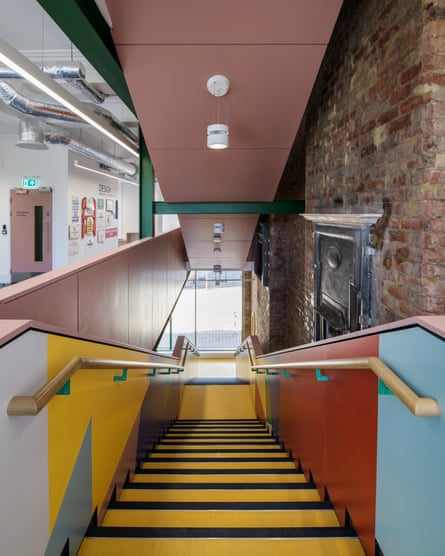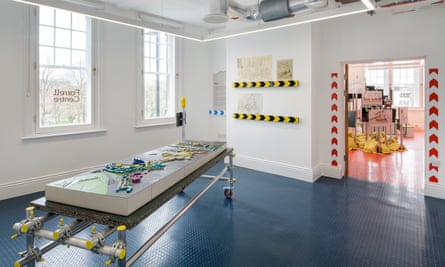[ad_1]
Architects are notoriously bad communicators. They have a tendency, while attempting to stride the multiple disciplines of construction, philosophy, sociology and art, to speak an opaque private language that is legible to none. Countless are the exhibitions where visitors are confronted with indigestible word salads of materialities, typologies, morphologies and phenomenologies, garnished with a good sprinkling of liminal palimpsests. It makes you want to run for the nearest the permeable threshold.
Planners can be just as bad. They casually throw around meaningless subjective terms like “in-keeping” and “overbearing”. What should be a transparent process of giving people a say over how their neighbourhoods are shaped has become a labyrinthine system of impenetrable complexity that would make Kafka jealous. In the tangled muddle of local plans, neighbourhood plans, masterplans and planning applications, it is almost impossible to find out what’s going on – and how your voice can be heard.

A new centre in Newcastle wants to change this. In a bid to knock down the wall between the people who make our cities and those who live in them, the distinguished architect Sir Terry Farrell has established a place to put the public at the centre of the urban debate. The £4.6m Farrell Centre, operated and funded by Newcastle University, with a £1m donation from Farrell, aims to be a welcoming and neutral arena where development proposals can be discussed, and the city’s past, present and future explored.
“I see it as a cross between Sir John Soane’s Museum and the Haçienda,” says the centre’s director, Owen Hopkins, describing an unlikely fusion the hallowed repository of architectural fragments and the former Manchester nightclub. “It’s a place of research, learning and, we hope, bold experimentation in terms of what we do and how we do it. At the same time, it’s deeply embedded in the culture of its place and brings people together and fosters debate in ways very different to those one might expect.”

Urbanist raves? Acid house planning meetings? Maybe. As far as Hopkins is concerned, nothing is off the table. Located in a grand Victorian commercial building, where leather goods were once made and sold, the Farrell Centre greets the street with a big shop window, set to display objects with a Tyneside link nominated by local people, and an open entrance lobby with a sunken seating area for talks. A jaunty scaffolding reception desk on wheels hints at the provisional nature of proceedings, while bright blue and yellow rubber floors, pink balustrades and green steelwork bring a pungent whiff of the 1980s, when Farrell was in his postmodern prime. Colourful Formica panels continue the theme up a new staircase, which thrusts past raw brick walls, where the original cast-iron fireplaces hang surreally mid-floor. The spirited refurb is the work not of Farrell, but local firms Space Architects and Elliott Architects, who have channelled a suitably playful spirit (if one that sometimes veers a little close to a daycare centre).
The first floor is home to a temporary exhibition gallery in four light-filled rooms, opening with More with Less: Reimagining Architecture for a Changing World. Embodying Hopkins’ professed experimental vibe, it sees four youngish offices charged with a wildly open brief, which essentially boils down to “do something interesting related to the climate emergency”.
A lumpy white vault structure fills the first room, with flaring arches inviting visitors to crawl inside, where they discover a cosy woollen cave within. It is the intriguing work of the university’s Hub for Biotechnology in the Built Environment, which “grew” the structure in the space using fungal mycelium and sawdust, plastered on to an armature of knitted wool from Lake District sheep. The beauty of mycelium as a building material, the researchers argue, is that it can be reactivated with water to change or repair the structure in future, and composted when no longer required. As a provocation for a kind of bio-building made from waste products and living organisms, it is a poetic thing (and worth wriggling inside for its unearthly acoustic alone).

A second room, by Glasgow studio Dress for the Weather, sees the space divided up with big panels of insulation, creating a little labyrinth of wood fibreboard and various kinds of fleece made from recycled bottles and wool. The intent was to demonstrate the effect of different levels of insulation, but the spaces all felt identical on my visit – perhaps because they hadn’t accounted for the air-source heating system whirring overhead. A third installation also misfires, taking the form of a meeting table with plants growing in the middle of it, designed by McCloy + Muchemwa as a lumbering metaphor for “giving nature a place at the table”.
Finally, Office S&M have filled their room with an assortment of interventions that embody their attitude of “luxurious thrift”. A silhouette of the head of Michelangelo’s David looks on from one wall, cut out of pink faux fur, while a piece of dichroic film covers a window, casting pearlescent light across the floor. A foil heat blanket hangs on another wall, with cat-flap shapes cut out of it. These cheap and cheerful veneers hint at low-cost and “delightful” ways to improve the thermal performance of buildings, without simply hiding insulation in the walls. A Frankenstein version of Le Corbusier and Charlotte Perriand’s famous modernist recliner chair stands in the middle of the room, its ponyskin seat exchanged for gloopy insulation foam. It is a striking and deliberately fragile object, intended to wear down during the course of the exhibition. But – like much in the show – it’s unclear what it’s doing here. If the Farrell Centre is keen to attract audiences unfamiliar with architecture, it might have to be a bit less gnomic than this.
Upstairs, on the second floor, are the “urban rooms”, the spiritual heart of the centre, with more scaffolding displays designed by CAN. First mooted in Farrell’s 2014 government review of architecture and the built environment, the idea was to have a space where the history and future of the city can be presented and discussed – something that already exists in a network of architecture centres, from Bristol to Folkestone. Farrell was inspired by what he had seen in China, where such centres feature enormous city models and elaborate interactive screens, but the Newcastle version is more low-key.
Privacy Notice: Newsletters may contain info about charities, online ads, and content funded by outside parties. For more information see our Privacy Policy. We use Google reCaptcha to protect our website and the Google Privacy Policy and Terms of Service apply.
after newsletter promotion

A series of historic maps introduce visitors to the evolution of the city, while a model from Farrell’s archive of his 2004 urban masterplan (for a “Geordie Ramblas”) suffices as a partial city model. Another room features a “planning forest” of assorted snippets of other masterplans, from the 1924 Burns Dick Plan for central Newcastle, to a recent speculative proposal for Byker Town, by Daniel Dyer of MawsonKerr architects. It all seems rather random and thrown together, lacking any sense of chronology or overarching structure, and will be heavily reliant on the centre’s staff to interpret the stories to visitors.
A final room, where events and workshops will take place, has a big stylised map of the region on the wall, where people are asked to add their answers to questions like “Where do you walk your dog? Which are you favourite green spaces? Where do you meet your friends?” Again, it’s not entirely clear what is to be gained from this Post-It-note engagement exercise.
What is oddly lacking, given the centre’s founding remit, is any evidence of current, live development proposals in and around Tyneside. Why not show the plans for the controversial £330m Gateshead Quays conference centre, which has been described as looking like “Dignitas North East”? Where are the designs for the new Malmö Quay tower in Ouseburn, called a “manky eyesore” at one public hearing, which has been redrawn after an overwhelming backlash? Both projects would benefit from the kind of through public discussion that the centre surely exists to foster.
“It was a conscious decision,” says Hopkins, whose background is in museum curation, rather than urban planning or public participation. “If we had too closely associated ourselves with a project, it could have overshadowed everything else. We want to be a convener and a platform. If we’re a campaigning body, we’re campaigning for a better built environment, whatever form that takes.”
It’s early days, and hopefully the centre will find its feet. But it must have the confidence to tackle difficult issues head on, rather than cosseting its subject in a world of benign, speculative propositions. Standing right across the street from the council’s planning office, this could be the ultimate public platform to air all sides of the debate, and drag the hidden mechanics of development out into the light.

